Day Tours
and
Independent Hospitality Receptions
| Agenda | Coverage | Lodging / Travel | Advertise/ Exhibit | Environmental News | About Sacramento |
Thursday, September 22, 2016
Registration
4:30 - 10:00 a.m. and Noon - 6:00 p.m.
Location: California Ballroom Foyer
If you didn't sign up ahead of time for the Saturday night party or Sunday brunch at the Library Galleria, there may still be room — please check with registration.
SEJ Information Table
All Day
Location: California Ballroom Foyer
Sign up here for Thursday Open Screen, Friday beat dinners and Saturday mini-tours. Read up on SEJ Board candidates, and find information about SEJ Award winners, membership and services. Pick up copies of SEJournal and other SEJ information.
Tours in the Field
Advance registration is required for all Thursday tours. Attendance on each tour is strictly limited, so registering early is important. Departure times vary (see below), but all Thursday tours will return to the Doubletree Hotel about 5:00 p.m. For those looking for some exercise, tours 1, 4 and 8 are your best options. Other tours involve moderate exercise. Tours 3 and 9 are best suited for wheelchair accessibility.
Buses will stage and depart from the parking lot outside the California Ballroom foyer, near registration. A cash-and-carry kiosk is available for tours leaving before 7:00 a.m.
Some tours might be able to take stand-by passengers. To tour standby, report to registration 20 minutes before the scheduled departure time and have your tour fee available. Standby passengers will be admitted on a first-come first-served basis after those already on a wait list.
Buses will return to the Sacramento Doubletree around 5:00 p.m. for a night of wining and dining by hosts of independent receptions. You'll find hors d'oeuvres, drinks, press kits, chats with environmental experts, good cheer and great networking.
1. Fire and Water: Lake Tahoe’s Ecological Splendor and Stressors
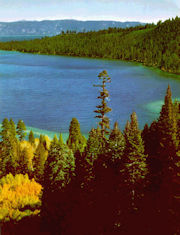 (5:00 a.m. departure, $40 fee, lunch included)
(5:00 a.m. departure, $40 fee, lunch included)
Lake Tahoe is the second deepest lake in the U.S., and one of the most beautiful. It is also threatened by stressors such as drought, climate change, development, wildfire and invasive species, which we will explore on this trip. The tour will include two tracks: land and water. We will ride a research boat with scientists from UC Davis and the University of Nevada, Reno, who have been monitoring the lake for many years. We will also take a hike with wildlife ecologists and wildfire experts, who will share with us their research on watershed restoration, wildlife ecology and more. You will be dazzled by the lake and its surrounding Sierra, and you will walk away with sources and story ideas that will resonate in other regions as well. Total drive time – 5 hours.
Tour Leaders:
Mary Catherine O'Connor, Independent Journalist
Amy Westervelt, Independent Journalist and Co-host, "Range: Stories of the New American West" Podcast
Speakers:
Brant Allen, Field Lab Director and Boat Captain, Lake Monitoring and Aquatic Ecology, University of California, Davis
Sudeep Chandra, Associate Professor of Limnology and Conservation Ecology, Natural Resources and Environmental Science, and Principal Investigator, Aquatic Ecosystems Analysis Laboratory at Tahoe, University of Nevada, Reno
Graham Kent, Director, Nevada Seismological Laboratory, and Professor, Department of Geological Sciences and Engineering, University of Nevada, Reno
Patricia Maloney, Project Scientist, Department of Plant Pathology, Tahoe Environmental Research Center, University of California, Davis
Christine Ngai, Fish Ecologist, Aquatic Ecosystems Analysis Laboratory at Tahoe, University of Nevada, Reno
Julie Regan, Chief of External Affairs, Tahoe Regional Planning Agency
Geoffrey Schladow, Director, Tahoe Environmental Research Center, and Professor of Civil and Environmental Engineering, University of California, Davis
2. Feeding the World: Big Ag, Big Impacts
(6:00 a.m. departure, $40 fee, lunch included)
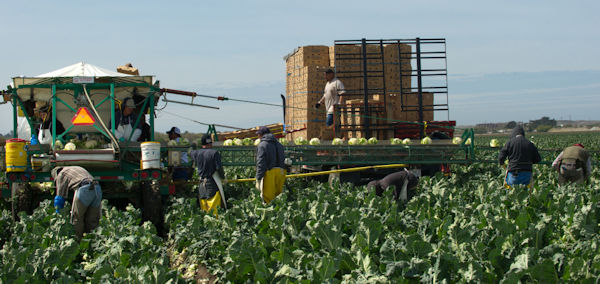 |
|
Cauliflower harvesting in Monterey County. Photo courtesy of John Chacon, California Department of Water Resources. |
It’s been called the breadbasket of the world, and for good reason. Farmers in California’s enormous Central Valley grow more than 250 crop varieties, generating tens of billions of dollars in revenue each year. But while many people have no idea where their food comes from, so, too, are they unaware of the environmental consequences of “Big Ag”: the conversion of historic wildlife habitat, the depletion of streams and groundwater, and the spraying of pesticides on the edge of urban communities. In fact, despite being surrounded by some of the world’s most fertile farmland, thousands of Valley residents live in “food deserts” without easy access to fresh fruits and vegetables. From the rice fields of the lower Sacramento Valley to the sweeping almond orchards of the San Joaquin, we’ll explore the successes and failures of agriculture and the implications for California and the U.S. Total drive time – 3 hours.
Tour Leaders:
Tony Barboza, Staff Writer, Los Angeles Times
Alex Breitler, Staff Writer, The (Stockton) Record
Speakers:
Daniel Bays, Third-generation Almond and Apricot Grower
Kathy Grant, Member, Lower Mokelumne River Watershed Stewardship Committee
LaCresia Hawkins, REACH Program Manager, Public Health Advocates
Eric Holst, Associate Vice President, Working Lands Program, Environmental Defense Fund
Aaron Lange, LangeTwins Family Winery and Vineyards
Emily Marquez, Staff Scientist, Pesticide Action Network
Arsenio Mataka, Assistant Secretary for Environmental Justice and Tribal Affairs, California Environmental Protection Agency
Katelyn Roedner Sutter, Environmental Justice Coordinator, Catholic Charities of Stockton
Chris Scheuring, Managing Counsel, California Farm Bureau Federation
Jeremy Terhune, Director, PUENTES
Jeff Wingfield, Director of Environmental & Public Affairs, Port of Stockton
3. Bodega Bay: Boats, Buoys and Bivalves
(6:15 a.m. departure, $40 fee, lunch included)
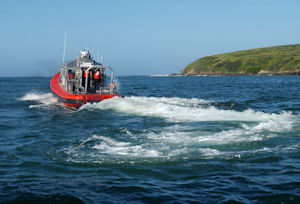 |
| The Mussel Point is launched in Bodega Bay. Photo courtesy of UC Davis. |
The California Coast and Pacific Ocean are a great starting point for understanding the environmental challenges and solutions offered on the other 71 percent of the planet that's blue. Bodega Bay is famous as the site where Alfred Hitchcock filmed "The Birds" (years before avian flu emerged). This tour will include visits to the Bodega Bay Coast Guard Station and UC Davis Bodega Marine Laboratory, with options to ride on an 87-foot Coast Guard Cutter and hike a natural headland. You’ll learn about scientists working with a local oyster company on ocean acidification, newly created marine protected areas and new research on oil spill response, sea level rise, marine noise pollution and other cutting-edge issues impacting the ocean, coasts and communities. And, we'll have Hog Island oysters after lunch. Total drive time – 4.5 hours. Coverage.
- 360° video of Bodega Marine Lab with scientist Tessa Hill (on Facebook)
Tour Leaders:
David Helvarg, Author and Executive Director, Blue Frontier
Rona Kobell, Staff Reporter, Chesapeake Bay Journal
Speakers:
Jim Clegg, Professor Emeritus, Department of Molecular & Cellular Biology and Bodega Marine Laboratory, University of California, Davis
Brian Gaylord, Professor, Department of Evolution and Ecology, and Bodega Marine Laboratory, University of California, Davis
Rick Grosberg, Professor of Evolution and Ecology, and Director, Coastal and Marine Science Institute, University of California, Davis
Deborah Halberstadt, Executive Director, California Ocean Protection Council
Tessa Hill, Associate Professor, Department of Earth & Planetary Sciences and Bodega Marine Laboratory, Coastal & Marine Sciences Institute, University of California, Davis
Suzanne Olyarnik, Director, Bodega Marine Reserve
Dirk Rosen, Director, Marine Applied Research & Exploration
Terry Sawyer, Founding Partner, Hog Island Oyster Co.
Michael Stocker, Acoustician and Executive Director, Ocean Conservation Research
Susan Williams, Professor, Bodega Marine Laboratory, Department of Evolution and Ecology, University of California, Davis
Coast Guard Representative from West Coast Strike Team – Oil Spill & Pollution Response
Representative from Fish School Alameda
4. Mercury Pollution, Wildfire and Fault Line Impacts on Lake Berryessa
(6:30 a.m. departure, $40 fee, lunch included)
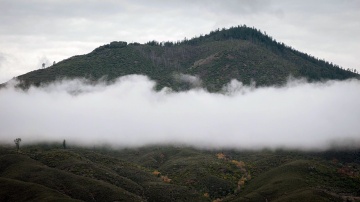 |
| Fog circling the rolling foothills and chaparral in the Berryessa Snow Mountain National Monument. U.S. Forest Service/Marc Garman |
When President Obama designated the Lake Berryessa landscape a national monument last year, it made headlines across the country. The biologically diverse region is full of active geysers, water snails, newts, mountain lions, bald eagles and leather oak. But, it’s also quietly recovering from environmental damage. Mercury mines from the 1950s left a trail of pollution. In fact, the lake’s grebes have the highest mercury levels in the state. And the Wragg fire scorched 8,000 acres last year, near the monument’s geologically active pull-apart basin. And then, there’s the drought. We’ll explore this beautiful and dynamic landscape on a morning hike, climbing 2,000 feet before discussions followed by lunch overlooking the lake. Total drive time – 3 hours. Coverage.
Tour Leaders:
Lindsey Hoshaw, Interactive Producer, KQED Science
Danielle Venton, Radio Reporter and Science Writer
Speakers:
Judy Ahmann, Land Owner and Rancher
Jeffrey Clary, Director, Stebbins Cold Canyon Natural Reserve, UC Davis Natural Reserve System
Adam Cline, Land Owner and Rancher
Stephen McCord, President, McCord Environmental, Inc.
Eldridge Moores, Distinguished Professor Emeritus, Structural Geology and Tectonics, Earth and Planetary Sciences, University of California, Davis
Bob Schneider, Senior Policy Director, Tuleyome
5. Mines, Vines and Wines: Gold and Grapes in the Sierra Nevada
(6:45 a.m. departure, $40 fee, lunch included)
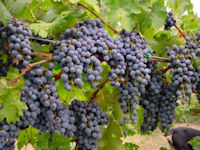 Deep in the Sierra foothills, we visit Gold Country and the remnants of California’s historic mining era. At Malakoff Diggins, the state’s biggest hydraulic mine, powerful water jets carved away cliffs to extract gold. Waste from hundreds of operations filled rivers and San Francisco Bay, carrying mercury that can taint fish 150 years later. Nearby stands the restored ghost town of North Bloomfield. September is harvest time for the reemerging wine industry here. We’ll go to vineyards and slake our miners’ thirst at tastings flourishing in the higher elevation complementary to rich red and crisp white grapes. Foothills farming experts tell us how changing climate, water scarcity and dynamic geology affect viticulture. Total drive time – 3.5 hours.
Deep in the Sierra foothills, we visit Gold Country and the remnants of California’s historic mining era. At Malakoff Diggins, the state’s biggest hydraulic mine, powerful water jets carved away cliffs to extract gold. Waste from hundreds of operations filled rivers and San Francisco Bay, carrying mercury that can taint fish 150 years later. Nearby stands the restored ghost town of North Bloomfield. September is harvest time for the reemerging wine industry here. We’ll go to vineyards and slake our miners’ thirst at tastings flourishing in the higher elevation complementary to rich red and crisp white grapes. Foothills farming experts tell us how changing climate, water scarcity and dynamic geology affect viticulture. Total drive time – 3.5 hours.
NOTE: There will be a $5 surcharge for tasting at one winery.
Tour Leaders:
Jane Kay, Environment Writer
Laura Mahoney, Sacramento Staff Correspondent, Bloomberg BNA
Speakers:
Charles Alpers, Research Chemist, California Water Science Center, U.S. Geological Survey
Matthew Green, Chief Ranger, Sierra District, California Department of Parks and Recreation
Elizabeth Martin, Chief Executive Officer, Sierra Fund
Dan Millsap, Project Management Supervisor, California Department of Parks and Recreation
Carrie Monohan, Science Director, Sierra Fund
Mike Naggiar, Owner, Naggiar Vineyards & Winery
Tapan Pathak, Extension Specialist, Climate Adaptation in Agriculture, Sierra Nevada Research Institute, University of California, Merced
Chris Smith, Owner, Smith Vineyard
Gary Smith, Owner, Smith Vineyard
Lynn Wunderlich, Farm Advisor, University of California Cooperative Extension
6. Living with Fire: Wildfires and Forest Health
(7:00 a.m. departure, $40 fee, lunch included)
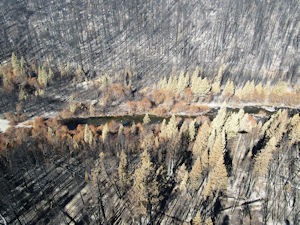 |
|
King Fire Burn Area. Photo courtesy of USFS. |
Last year, wildfires nationwide burned more than 10 million acres and firefighting costs skyrocketed to $2.1 billion. More than 2,000 homes in California alone were destroyed by wildfire. We’ll head to the Eldorado National Forest, where the King Fire burned 97,000 acres in 2014 and scorched 50,000 acres in just one day. We’ll examine the effects of large-scale wildfires in the Sierra Nevada and discuss fire behavior in the face of drought and climate change. We’ll learn about the current and historical role of fire and how it affects a watershed, species diversity and wildlife habitat. We’ll take a hike at the Blodgett Forest Research Station, where since the 1950’s UC Berkeley scientists have studied ways to improve forest management. We’ll also visit homeowners who lost property during the King Fire and talk about living in the wildland-urban interface. Total drive time – 3 hours.
Tour Leaders:
Jane Braxton Little, Freelance Journalist
Amy Quinton, Environment Reporter, Capital Public Radio
Speakers:
Tom Boscow, Homeowner, Pacific House, CA
Jennifer Chapman, Public Affairs Officer, Eldorado National Forest
Mark Egbert, District Manager, El Dorado County & Georgetown Divide Resource Conservation Districts
Becky Estes, Central Sierra Province Ecologist, Pacific Southwest Region, U.S. Forest Service
Alissa Fogg, Central & South Sierra Program Leader, Point Blue Conservation Science
Malcolm North, Research Associate, Department of Plant Sciences, College of Agricultural and Environmental Sciences, University of California, Davis; and Research Scientist, Ecosystem Function and Health, Pacific Southwest Research Station, U.S. Forest Service
Scott Stephens, Professor of Fire Science and Chair, Division of Ecosystem Science, Department of Environmental Science, Policy & Management, College of Natural Resources, University of California, Berkeley
Pat Trimble, District Ranger, Georgetown Ranger District, Eldorado National Forest
Dana Walsh, Silviculturist, North Zone, Eldorado National Forest
George Wuerthner, Author, "Wildfire: A Century of Failed Forest Policy" and "Yellowstone & the Fires of Change"
Rob York, Research Stations Manager and Adjunct Assistant Professor of Forestry, Center for Forestry, University of California, Berkeley
7. Water Is for Fighting: Drought, Water Supply and Climate Change
(7:30 a.m. departure, $40 fee, lunch included)
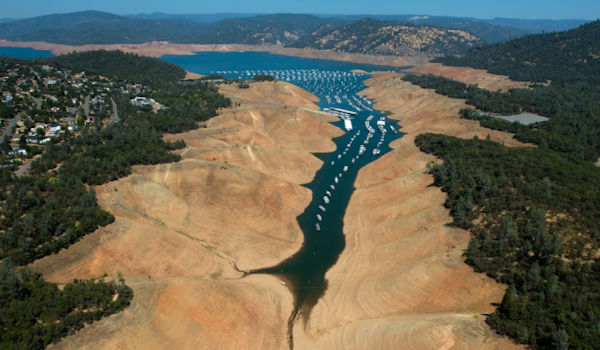 |
| Lake Oroville in drought (2014), courtesy of Kelly M. Grow, California Department of Water Resources. Click to enlarge. |
Take a visit to ground zero of California’s water wars: the Sacramento-San Joaquin Delta. The largest estuary on the West Coast is the central hub of the state’s vast and antiquated water- delivery system. Conflicts here over Delta water signal what’s to come across the country amid climate change. You’ll visit huge water pumps so powerful they can make rivers run backwards in order to ship water hundreds of miles to Southern California. You’ll see massive fish screens that seek to protect several species of endangered fish. You’ll hear from supporters and detractors of a controversial plan to re-plumb this fragile estuary. The trip will feature a boat tour and, if time allows, a beer break at the quaint and quirky Fosters’ Bighorn saloon in Rio Vista. Total drive time – 4 hours. Coverage.
Tour Leaders:
Ryan Sabalow, Reporter, The Sacramento Bee
Lauren Sommer, Science Reporter, KQED
Speakers:
Brian Bergamaschi, Biogeochemist, U.S. Geological Survey
Jon Burau, Hydrodynamics Project Chief, U.S. Geological Survey
Jay Lund, Director, Center for Watershed Sciences and Professor, Department of Civil and Environmental Engineering, University of California, Davis
Karla Nemeth, Deputy Secretary for Water Policy, California Natural Resources Agency
Roger Patterson, Assistant General Manager, Metropolitan Water District of Southern California
Kate Poole, Senior Attorney, Natural Resources Defense Council
8. Kayaking California’s Imperiled Inland Sea
(7:45 a.m. departure, $50 fee, includes lunch and kayak rental; kayakers will be on the water for 60 to 70 minutes, making it a gentle to moderate paddle)
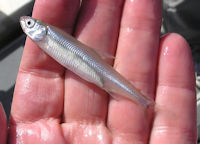 |
|
Delta smelt. Photo courtesy of USFWS. |
We’ll paddle through marshes and a flooded island and examine environmental problems that have brought the Delta smelt to the edge of extinction — if not over it — and caused havoc with other wild fish. We’ll set out from the Big Break Regional Shoreline to get a sea-level view of California’s huge Sacramento-San Joaquin River Delta, ground zero for the struggle to allocate water between fish, farms and people. Peter Moyle, the UC Davis scientist who alerted the public to the brewing demise of the smelt, will be among our expert guests. We’ll lunch at the Big Break natural history center and afterwards check out part of the Suisun Marsh, the largest brackish water estuary on the West Coast and home to duck clubs and extensive waterfowl habitat. Total drive time – 3.5 hours. Coverage.
Tour Leaders:
Denis Cuff, Reporter, Bay Area News Group
Tim Wheeler, Managing Editor & Project Writer, Chesapeake Bay Journal
Speakers:
Gary Bobker, Rivers and Delta Program Director, The Bay Institute
Holly Heyser, Editor, California Waterfowl Magazine
Mike Moran, Supervising Naturalist, East Bay Regional Park District Visitor Center, Big Break Regional Shoreline
Peter Moyle, Professor Emeritus, Department of Wildlife, Fish and Conservation Biology; and Associate Director, Center for Watershed Sciences, University of California, Davis
Jason Peltier, Executive Director, San Luis Delta Mendota Water Authority
Carl Wilcox, Delta Policy Advisor to the Director, California Department of Fish and Wildlife
9. California: The Clean Energy Proving Ground
(9:00 a.m. departure, $40 fee, lunch included)
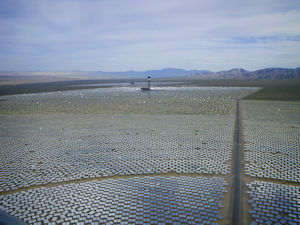 |
|
Ivanpah Solar Farm. Photo courtesy of USFWS. |
In October 2015, California Governor Jerry Brown signed legislation that codified two goals from his 2015 inaugural address: increasing energy efficiency in California buildings by 50 percent and generating half of the state’s electricity from renewable sources by 2030. This tour offers a glimpse of how California plans to meet the ambitious targets. We begin with a visit to the California Independent System Operator, including a tour of the control room, the nerve center of the state’s grid. Next, we visit 2500 R Midtown, a net-zero energy neighborhood, touring homes equipped with rooftop solar panels and advanced energy storage systems. Last, we visit CleanWorld’s Sacramento anaerobic bio-digester, which converts up to 100 tons of food waste daily into renewable natural gas, electricity and fertilizer. Total drive time – 2.5 hours. Coverage.
Tour Leaders:
Justin Gerdes, Independent Journalist
Sarah Terry-Cobo, Energy Reporter, The Journal Record (Oklahoma City)
Speakers:
John Adair, Resident, 2500 R Midtown
Matt Campbell, Vice President, SunPower
Chris Capra, Public Information Specialist, Sacramento Municipal Utility District
Joseph Desmond, Senior Vice President, Marketing and Government Affairs, BrightSource Energy
Steven Greenlee, Senior Public Information Officer, Cal ISO
Lupe Jimenez, Smart Grid Senior Project Manager, Sacramento Municipal Utility District
Larissa Koehler, Attorney, California Clean Energy Team, Environmental Defense Fund
Debi Le Vine, Director of System Operations, Cal ISO
Paul Schwartz, Resident, 2500 R Midtown
Julie Southern, Resident, 2500 R Midtown
Andrea Stephenson, Marketing Manager, CleanWorld
Ruihong Zhang, Professor, Department of Biological and Agricultural Engineering, University of California, Davis
Bookstore
5:00 - 9:00 p.m.
Location: California Ballroom Salons 1/2, Booths 11/12
The UC Davis bookstore is on site to sell SEJ members' and speakers' books, as well as offering environmental books handpicked for the SEJ conference. Authors book signings are scheduled from 8:00 - 9:00 p.m.
Independent Hospitality Receptions and Exhibits
5:00 - 9:00 p.m.
Location: California Ballroom
 Now a popular SEJ tradition, this is the conference’s best networking opportunity. After spending the day out and about on tours, meet with the hosts of multiple receptions (read their invitations here). They’ll have experts on hand, as well as displays, materials and, of course, great food and drink. There are multiple locations, so be prepared to make the rounds — and don’t miss the sneak peek at exhibits and alternative-fuel vehicles. Sign up for test-drives during the receptions.
Now a popular SEJ tradition, this is the conference’s best networking opportunity. After spending the day out and about on tours, meet with the hosts of multiple receptions (read their invitations here). They’ll have experts on hand, as well as displays, materials and, of course, great food and drink. There are multiple locations, so be prepared to make the rounds — and don’t miss the sneak peek at exhibits and alternative-fuel vehicles. Sign up for test-drives during the receptions.
- Outside the California Ballroom Foyer: Diesel Technology Forum
- Grand Ballroom: Environmental Defense Fund, Novozymes, The Walton Family Foundation, The Wilderness Society — plus VW/Audi and other exhibits
- California Foyer: The Pew Charitable Trusts and test-drive sign-up tables
- California Ballroom Salons 1/2: Booths and tables, including the UC Davis Bookstore
- California Ballroom Salon 3: Bracewell
Wednesday, September 21
Friday, September 23
Saturday, September 24
Sunday, September 25







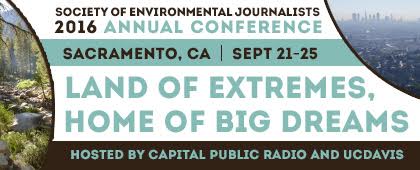





 Advertisement
Advertisement 



